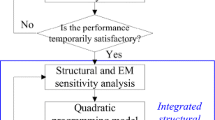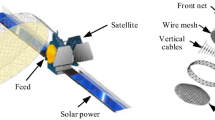Abstract
To alleviate the effects of random structural errors on the radiation performance and directly guide the structural design of cable mesh reflectors, an integrated structural-electromagnetic optimization procedure is proposed considering the radiation pattern degradation for random structural errors. Based on analytical expressions and the structural sensitivity concept, the radiation pattern is directly expressed as two matrix-form functions with respect to the random structural errors. By applying the pattern calculation into the multidisciplinary design and selecting the average boresight directivity as the objective function, an optimum result with better radiation performance compared with the traditional structural design is obtained. To reveal the fundamentals of the optimum result, the concept of sensitivity analysis of the average boresight directivity with respect to the random structural errors is introduced. The effectiveness and benefits of this study are demonstrated via an offset cable mesh reflector.
















Similar content being viewed by others
References
Bahadori K, Rahmat-Samii Y (2005) Characterization of effects of periodic and aperiodic surface distortions on membrane reflector antennas. IEEE Trans Antennas Propag 53(9):2782–2791
Chahat N, Hodges RE, Sauder J, Thomson M, Peral E, Rahmt-Samii Y (2016) CubeSat deployable Ka-band mesh reflector antenna development for earth science missions. IEEE Trans Antennas Propag 64(6):2083–2093
Deng H, Li T, Wang Z (2015) Pretension design for space deployable mesh reflectors under multi-uncertainty. Acta Astronaut 115:270–276
Du J, Zong Y, Bao H (2013) Shape adjustment of cable mesh antennas using sequential quadratic programming. Aerosp Sci Technol 30:26–32
Du J, Bao H, Cui C (2014) Shape adjustment of cable mesh reflector antennas considering modeling uncertainties. Acta Astronaut 97:164–171
Fu K, Du J, Li J, Zhao Z (2018) Robust design of tension truss antennas against variation in tension truss. AIAA J 56(8):3374–3381
Haftka RT, Adelman HM (1985) An analytical investigation of shape control of large space structures by applied temperatures. AIAA J 23(3):450–457
Haftka RT, Adelman HM (1987) The effect of sensor and actuator errors on static shape control of large space structures. AIAA J 25(1):134–138
Hill J, Wang KW, Fang H (2013) Advances of surface control methodologies for flexible space reflectors. J Spacecr Rocket 50(4):816–828
Liu JS, Hollaway L (1998) Integrated structure-electromagnetic optimization of large reflector antenna systems. Struct Optim 16(1):29–36
Padula SL, Adelman HM, Bailey MC, Haftka RT (1989) Integrated structural electromagnetic shape control of large space antenna reflectors. AIAA J 27(6):814–819
Rahmat-Samii Y (1983) An efficient computational method for characterizing the effects of random surface errors on the average power pattern of reflectors. IEEE Trans Antennas Propag 31(1):92–98
Rocca P, Anselmi N, Massa A (2014a) Interval arithmetic for pattern tolerance analysis of parabolic reflectors. IEEE Trans Antennas Propag 62(10):4952–4960
Rocca P, Manica L, Massa A (2014b) Interval-based analysis of pattern distortions in reflector antennas with bump-like surface deformations. IET Microw Antennas Propag 8(15):1277–1285
Ruze J (1966) Antenna tolerance theory-a review. P IEEE 54(4):633–640
Sinton S, Rahmat-Samii Y (2003) Random surface error effects on offset cylindrical reflector antennas. IEEE Trans Antennas Propag 51(6):1331–1337
Smith WT, Bastian RJ (1997) An approximation of the radiation integral for distorted reflector antennas using surface-error decomposition. IEEE Trans Antennas Propag 45(1):5–10
Tabata M, Yamamoto K, Inoue T, Noda T, Miura K (1992) Shape adjustment of a flexible space antenna reflector. J Intell Mater Syst Struct 3(4):646–658
Tolson RH, Huang JK (1992) Integrated control of thermally distorted large space antennas. J Guid Control Dyn 15(3):605–614
Yamaki Y, Sato Y, Izui K, Yamada T, Nishiwaki S, Hirai Y (2018) A heuristic approach for actuator layout designs in deformable mirror devices based on current value optimization. Struct Multidiscip Optim 58:1243–1254
Yang D, Zhang Y, Yang G, Du J (2018) Least-squares minimization of boundary cable tension ratios for mesh reflectors. AIAA J 56(2):883–888
Zhang S, Duan B, Yang G, Zong Y, Zhang Y (2013) An approximation of pattern analysis for distorted reflector antennas using structural-electromagnetic coupling model. IEEE Trans Antennas Propag 61(9):4844–4847
Zhang S, Du J, Duan B, Yang G, Ma Y (2015) Integrated structural-electromagnetic shape control of cable mesh reflector antennas. AIAA J 53(5):1395–1398
Zhang S, Du J, Wang W, Zhang X, Zong Y (2017a) Two-step structural design of mesh antennas for high beam pointing accuracy. Chin J Mech Eng 30:604–613
Zhang S, Du J, Yang D, Zhang Y, Li S (2017b) A combined shape control procedure of cable mesh reflector antennas with optimality criterion and integrated structural electromagnetic concept. Struct Multidiscip Optim 55:289–295
Zhang S, Duan B, Huang J, Gu Y (2018) Fast pattern calculation of rib reflectors with varying surface distortions. IEEE Trans Antennas Propag 66(3):1198–1207
Acknowledgments
The authors would like to thank the reviewers and editor for their very beneficial comments and suggestion, which helped a lot in improving this paper.
Funding
This work was supported by the National Natural Science Foundation of China No. 51705388 and Young Talent fund of University Association for Science and Technology in Shaanxi, China.
Author information
Authors and Affiliations
Corresponding author
Ethics declarations
Conflict of interest
The authors declare that they have no conflict of interest.
Replication of results
The presented results in both the structural and electromagnetic disciplines are produced by subroutines using our in-house codes, which compute the structural sensitivity matrices and the average radiation patterns for cable mesh reflectors with random structural errors, respectively. The optimization iteration is implemented with the help of fmincon in the optimization toolbox of MATLAB software. The code and data for producing the presented results will be made available by request.
Additional information
Responsible Editor: Raphael Haftka
Publisher’s note
Springer Nature remains neutral with regard to jurisdictionalclaims in published maps and institutional affiliations.
Appendix
Appendix
Sensitivity matrix of the facet link point displacements with respect to the structural cable length imperfections
The sensitivity matrix of the facet link point displacements with respect to the structural cable length imperfections in (6) is obtained as follows (Du et al. 2013):
where \( {K}_c^{11} \) and \( {K}_s^1 \) are the partitioned matrices according to the interior facet link points in the cable mesh reflector.
The partitioned matrices are expressed as
where Σ is the standard finite element assembly operator, Kck is the element axial stiffness matrix, and Ksk is the geometric stiffness matrix due to the cable.
The element axial stiffness matrix Kck and the geometric stiffness matrix Ksk are respectively deduced as
and
where E is the elastic modulus, A is the cable cross-sectional area, L is the cable length in the stress state, L0 is the cable initial dimension, rp and rq are the position vectors of the facet link points in one cable as shown in Fig. 17, and I3 × 3 is a 3 × 3 identity matrix.
Rights and permissions
About this article
Cite this article
Zhang, S., Duan, B. Integrated structural-electromagnetic optimization of cable mesh reflectors considering pattern degradation for random structural errors. Struct Multidisc Optim 61, 1621–1635 (2020). https://doi.org/10.1007/s00158-019-02439-9
Received:
Revised:
Accepted:
Published:
Issue Date:
DOI: https://doi.org/10.1007/s00158-019-02439-9





